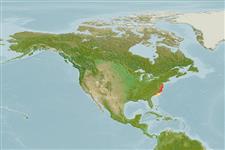Environment: milieu / climate zone / depth range / distribution range
Ecología
marino; agua dulce; salobre demersal; anfidromo (Ref. 40808); rango de profundidad 0 - 75 m (Ref. 57178), usually 50 - 60 m (Ref. 51483). Subtropical; 5°C - 22°C (Ref. 13614); 43°N - 9°N, 79°W - 74°W (Ref. 57273)
Western Central Atlantic: Massachusetts to Florida, throughout the Gulf of Mexico, to Panama.
Length at first maturity / Tamaño / Peso / Age
Maturity: Lm ? range ? - ? cm
Max length : 20.0 cm TL macho / no sexado; (Ref. 7251); common length : 11.0 cm TL macho / no sexado; (Ref. 12193); edad máxima reportada: 7 años (Ref. 51483)
Adults inhabit coastal waters. They also enter fresh waters, going hundreds of miles upstream. Migrate downstream to spawn in spring (Ref. 36739). Larvae move upstream after hatching (Ref. 36739). Minimum depth reported taken from Ref. 57178.
Robins, C.R. and G.C. Ray, 1986. A field guide to Atlantic coast fishes of North America. Houghton Mifflin Company, Boston, U.S.A. 354 p. (Ref. 7251)
IUCN Red List Status (Ref. 130435)
Threat to humans
Harmless
Human uses
Pesquerías: sin interés
Herramientas
Special reports
Download XML
Fuentes de Internet
Estimates based on models
Preferred temperature (Ref.
123201): 11.4 - 24.5, mean 17.2 °C (based on 60 cells).
Phylogenetic diversity index (Ref.
82804): PD
50 = 0.5010 [Uniqueness, from 0.5 = low to 2.0 = high].
Bayesian length-weight: a=0.01318 (0.00764 - 0.02276), b=3.07 (2.92 - 3.22), in cm total length, based on LWR estimates for this species & (Sub)family-body (Ref.
93245).
Nivel trófico (Ref.
69278): 3.4 ±0.5 se; based on size and trophs of closest relatives
Generation time: 5.6 ( na - na) years. Estimated as median ln(3)/K based on 1
growth studies.
Resiliencia (Ref.
120179): Medio, población duplicada en un tiempo mínimo de 1.4-4.4 años (tm=1; tmax=7; K=0.21(?)).
Fishing Vulnerability (Ref.
59153): Moderate vulnerability (37 of 100).
Nutrients (Ref.
124155): Calcium = 110 [48, 247] mg/100g; Iron = 0.938 [0.463, 1.756] mg/100g; Protein = 18.2 [16.8, 19.5] %; Omega3 = 0.226 [0.110, 0.434] g/100g; Selenium = 19.6 [9.7, 42.5] μg/100g; VitaminA = 16 [5, 56] μg/100g; Zinc = 0.964 [0.630, 1.421] mg/100g (wet weight);
